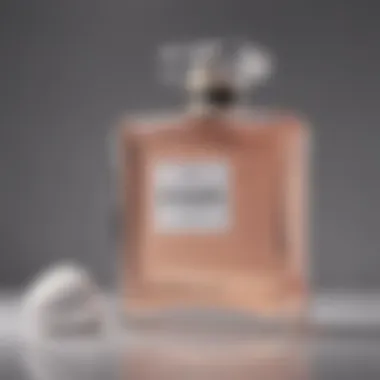The Timeless Allure of Chanel No. 5's Fragrance


Intro
Chanel No. 5, an olfactory wonder, stands out in the world of fragrances like a classic novel on a crowded bookshelf. Introduced in 1921, it has seen the world through different lenses, adapting as societal norms evolved while remaining true to its core identity. The fragrance is more than just a scent; it’s a storied tradition, embodying the essence of glamour and sophistication.
At its heart, Chanel No. 5 offers a diverse array of fragrance notes that dance together to create an unforgettable experience. From the bright top notes to the deeper base notes, the complexity is what draws one in and keeps them coming back for more. In this exploration, we will peel back the layers of Chanel No. 5, examining the individual notes that come together to form its signature aroma, along with the history and significance behind it.
The appeal of Chanel No. 5 reaches beyond just perfume lovers; it speaks to anyone captivated by stories of creation, artistry, and cultural impact. By diving deep into its fragrance palette, we can understand the timeless allure that has kept generations enchanted.
Key Points to Discuss
- Historical Context: An insight into the period surrounding its creation and the vision of Coco Chanel.
- Fragrance Notes Analysis: A detailed look at the top, middle, and base notes that contribute to its distinctive scent.
- Cultural Impact: How Chanel No. 5 has influenced not just the fragrance industry, but also fashion and popular culture.
Through this article, the aroma of Chanel No. 5 will unfurl before our very eyes, offering a rich tapestry of flavor and memory that underscores its status as a true classic.
Beauty Tips and Tricks
While Chanel No. 5 shines primarily as a fragrance, there's a lot one can learn about integrating such an iconic scent into broader beauty practices. Just as one would meticulously apply makeup or blend skincare products, the artistry in wearing Chanel No. 5 is also worth exploring.
Enhancing your Experience
- Layering Scents: Chanel No. 5 stands on its own, but experimenting with complementary body lotions can add to its depth. Look for unscented or subtly scented moisturizers to avoid overpowering the fragrance.
- Application Techniques: When applying, focus on pulse points – behind the ears, on the wrists, and the base of the throat. This helps the fragrance bloom naturally throughout the day.
- Storing Your Fragrance: Keep Chanel No. 5 in a cool, dark place. Storing it away from direct sunlight can help maintain its integrity over time.
"A fragrance is like a snapshot in time. That moment when you breathe it in can conjure memories and emotions beyond words."
Tailoring Your Routine
- Complementary Beauty Products: Consider makeup palettes or skincare regimes that match the elegance of Chanel No. 5. Earthy tones and classic red lips can enhance the timeless quality of the fragrance.
- Seasonal Adjustments: In winter, you might enjoy pairing it with richer scents or thicker lotions, while lighter, airy products work well in warmer months.
In summary, while Chanel No. 5 is undoubtedly a star on its own, there are clever tricks and thoughtful routines to amplify and celebrate its presence in our daily beauty rituals.
History of Chanel No.
The narrative of Chanel No. 5 intertwines with the life of its creator, Gabrielle "Coco" Chanel, and stretches back to the early 20th century. Understanding the history of this iconic fragrance is crucial as it not only contextualizes its intricate scent profile but also illustrates the cultural shifts and fashion revolutions it influenced. Chanel No. 5 isn't just a perfume; it's a symbol of liberation, femininity, and innovative spirit. By exploring its origins, we gain insight into the artistry behind fragrance creation and the social landscapes that shaped its reception.
The Origins of the Fragrance
Chanel No. 5's origins can be traced to 1921, when Coco Chanel sought to create a scent that would embody the essence of modern womanhood. Unlike traditional fragrances that often leaned toward a singular floral scent, Chanel envisioned a complex blend that fused various notes, marrying simplicity with sophistication.
Chanel collaborated with Ernest Beaux, a perfumer whose creativity and technical prowess helped translate her vision into a tangible product. The initial trials involved numerous formulations. Legend has it that Chanel selected the fifth sample presented to her, marking the fragrance as her signature. This decision wasn’t just about the scent; it was about taking a bold step into a new era of perfumery that prioritizes the individuality of the wearer.
"A woman who doesn't wear perfume has no future."
- Gabrielle Chanel
The Vision of Gabrielle Chanel
Coco Chanel was a pioneer, reshaping the way women viewed themselves and expressed their identities. She understood that fragrance had immense power; it could evoke emotions, create memories, and convey status. Chanel No. 5 was intended to transcend the mere act of smelling good. It was about making a statement—a blend that spoke to a woman’s strength, independence, and modernity.
Chanel’s vision was not just about the fragrance; it was a manifesto of sorts. In contrast to the complex, often suffocating norms of femininity those days, Chanel No. 5 emerged as a breath of fresh air. The use of synthetic aldehydes, particularly prominent in this scent, revolutionized perfumery by allowing more freedom in creative expression. Through Chanel No. 5, Chanel effectively opened a gateway for women to embrace their choices boldly, both in life and in scent.
The Role of Ernest Beaux
Ernest Beaux played a pivotal role in the making of Chanel No. 5. As a distinguished perfumer with a wealth of experience, Beaux crafted a fragrance from a myriad of raw materials, which included both naturals and syntheses. His innovative approach made Chanel No. 5 a groundbreaking composition, utilizing aldehydes to enhance the fragrance's complexity and lift it beyond mere floral notes.
Beaux's background was infused with inspiration from his experiences with luxury and opulence, which helped shape the luxurious allure of the perfume. He not only blended ingredients but also infused Chanel’s vision with his technique, resulting in a scent that was both avant-garde and undeniably classic. In combining traditional and modern elements, Beaux solidified his legacy and marked Chanel No. 5 as a genre-defining fragrance.
Closure
The history surrounding Chanel No. 5 is layered with ambition, daring innovation, and cultural rebirth. Each element—from the choice of ingredients to the identities of those involved—has contributed to making it an enduring symbol of elegance and taste. The fragrance’s past not only enhances the depth of its scent but also reinforces its status as an icon in the fragrance universe.
Understanding Fragrance Notes
The realm of fragrance notes is the foundation for any scent composition, including the iconic Chanel No. 5. Understanding this topic is essential because it reveals how different scents work together to create a unique aromatic experience. Each category of notes—top, middle, and base—contributes distinct characteristics and play a role at various stages of how a fragrance is experienced. This exploration of fragrance notes provides insight into not only the art of perfume crafting but also the emotional and sensory connections that a fragrance can evoke.
In the context of Chanel No. 5, grasping the interplay of these notes allows enthusiasts to appreciate the fragrance's complexity and depth. The careful balance between freshness, floral elegance, and warmth serves to create an enduring signature that has captivated many. Knowing these layers helps in selecting perfumes that resonate with one's individual taste and preferences, enhancing the overall experience.
Top Notes
Prolusion to Top Notes
Top notes are the first impression of a fragrance, making them crucial for an immediate emotional response. These initial scents are typically light, airy, and dissipate quickly, usually within 15 to 30 minutes after application. They are the flashiest part of any perfume, designed to catch the attention of the wearer and those around them.
In Chanel No. 5, top notes such as bergamot and lemon offer brightness. They are not only refreshing but also set the stage for the more complex scents that follow. This delicate temporal span makes them a popular choice, as these notes also compel individuals to explore the heart and base notes that linger longer.
Unique to top notes is their ephemeral nature; however, they offer the advantage of creating an inviting allure right off the bat. In this regard, they pave the way for richer aromatic layers, yet could be viewed as a disadvantage by individuals who prefer a stable aroma that lingers longer.
Common Top Notes Found in Chanel No.
In examining common top notes in Chanel No. 5, one can easily identify the lively citrus and floral elements. bergamot, neroli, and aldehydes come to the forefront, contributing uniquely to the fragrance’s distinctive character. Aldehydes, in particular, provide a sparkling quality that differentiates Chanel No. 5 from others.


These notes offer a tantalizing introduction that stirs curiosity in the fragrance. Their combination brings a light sophistication, engaging the senses to entice users into a deeper exploration of the fragrance’s richness. The downside, as noted earlier, is that these notes vanish swiftly, making it fundamental for wearers to engage with the evolving scent journey.
Middle Notes
Defining the Heart of the Fragrance
Middle notes, or heart notes, play a pivotal role as they emerge right after the top notes dissipate. This section of fragrance is usually composed of heavier, fuller scents that establish the essence of the perfume. In Chanel No. 5, jasmine and rose are the lead players, imparting a rich floral bouquet that anchors the fragrance.
The power of middle notes is that they create depth and body. They often last longer than top notes but are short-lived compared to base notes. Their composition can determine how a fragrance evolves over time, making them a significant focus in Chanel No. 5. This balance encourages emotional connectivity with the fragrance, as wearers may feel enveloped by its warmth.
The unique feature of heart notes is their ability to bridge the initial impression with the lasting scent. However, this stage can be seen as a double-edged sword; if the middle notes underperform or clash with personal preferences, they can mar the initial attraction established by the top notes.
Diversity of Middle Notes in Chanel No.
The diversity of the middle notes in Chanel No. 5 contributes enormously to its allure. Alongside jasmine and rose, notes such as ylang-ylang and lily also make an appearance, ensuring a lush, multi-faceted aroma. The complexity found within these middle notes allows for a dynamic fragrance that shifts subtly as the wearer goes about their day.
What makes Chanel No. 5 particularly exceptional is this signature blend of floral heart tones that harmonizes effortlessly. It is not just about floral dominance; the diversity enriches the experience, inviting wearers to appreciate the nuances. This diverse composition may encourage some preferences, while others may find it a tad overwhelming if they're fond of simpler scents.
Base Notes
The Lasting Impression of Base Notes
Base notes form the foundation of a fragrance, delivering the lasting impression that stays long after the perfume has been applied. These notes are typically rich, heavy scents that evolve slowly and can linger for hours or even days. In Chanel No. 5, sandalwood and vanilla provide warmth and sensuality, becoming the comforting end of a well-crafted perfumery experience.
Base notes anchor the entire fragrance, giving it longevity and depth. This is especially beneficial for those who appreciate a scent that evolves over time. However, if the base notes are too overwhelming, they can overshadow the delicate balance created by the heart and top notes, leading to a fragrance experience that may not appeal to everyone.
Key Base Notes Used in Chanel No.
The key base notes used in Chanel No. 5 deserve special mention. In addition to sandalwood and vanilla, amber adds a unique warmth, while musk introduces an element of mystery and softness. This rich chord leaves a trail, ensuring that the wearer carries a hint of the fragrance long after it’s been sprayed.
The intriguing aspect of base notes lies in their complex interplay with the preceding notes. They can transform the entire aromatic profile into a uniquely personal experience. While their lasting power is advantageous, it can also mean that some users may need to be mindful of the strength of the base, as it can sometimes overpower the subtler notes that initially attracted them to the scent.
The Scent Family of Chanel No.
Understanding the scent family of Chanel No. 5 is essential for grasping the fragrance's captivating charm and enduring appeal. Think of it as a musical composition, where various notes combine to create a harmonious symphony. The fragrance is built around three principal scent families: floral, woody, and spicy. Each category plays its own role, creating an elaborate olfactory experience that speaks volumes about sophistication and luxury.
In this section, we will break down these characteristics to understand their significance and how they contribute to making Chanel No. 5 a timeless classic that resonates with both beauty enthusiasts and casual wearers alike.
Floral Characteristics
At its core, Chanel No. 5 is anchored in floral aromas, often considered the heart of perfumery. The floral notes evoke feelings of elegance and femininity. It often starts with vibrant scents like jasmine and rose, which form the opening act of this symphonic fragrance. These notes are lush and romantic, providing a bright, fresh burst that delays the more profound notes below.
Some key floral elements:
- Jasmine: Adds a soft, sensual touch that enhances the overall richness.
- Rose: Often associated with love, its complexity adds depth, making it a perfect counterpart to jasmine.
- Lilies: These give a subtle airiness, lifting the fragrance without overpowering.
The fascinating part about the floral aspect is how it intertwines with the other notes, creating a seamless transition throughout the wearing experience. Without these floral notes, the fragrance would lose its signature femininity, blending into a more generic scent.
Woody Undertones
The woody undertones of Chanel No. 5 provide a robust base, grounding the exuberant floral top notes. These undertones add richness and complexity, making the fragrance well-rounded and durable on the skin. Woods such as sandalwood and cedar lend a sense of warmth and depth, transforming the initial floral burst into something deeper and more substantial.
Key aspects of the woody profile:
- Sandalwood: Known for its creamy and rich characteristics, it gives Chanel No. 5 an earthiness that softens the stronger floral elements.
- Cedar: Brings a fresh, sharp quality, complementing the sweetness without overshadowing it.
Together, these woody notes create a layered experience that keeps the fragrance alive throughout the day, presenting the evolving nature of the scent as different notes come into play over time.
Spicy Accents
Adding even more intrigue to Chanel No. 5 are the spicy accents, which act as an unexpected twist within the fragrance palette. Just when you think you have it figured out with florals and woods, a hint of spice kicks in and revitalizes the experience. Notes of pepper or musk can create a sensational trail, subtly shifting the fragrance towards something exciting and bold.
Why spicy accents matter:
- They provide contrast, preventing the scent from becoming one-dimensional.
- They add a layer of mystery, making it not just a fragrance but a conversation starter.
Spicy notes can often be the secret ingredient that prompts a lingering thought in the wearer’s mind—an itch to revisit the fragrance as it reveals new facets in different environments or seasons.
"A true fragrance is like a story—each note is a character, collectively narrating an experience, a moment in time."
Cultural Impact of Chanel No.
Chanel No. 5 is more than just a fragrance—it's a symbol woven into the very fabric of modern culture. Its influence spreads far beyond the world of beauty, carving a space in fashion, media, and even folklore. Understanding its cultural impact reveals how this scent has resonated through decades and what it represents in today's societal context.
Influence on Fashion
Chanel No. 5 has undeniably shaped the landscape of fashion since its inception. Gabrielle "Coco" Chanel herself revolutionized not only perfumery but also women's fashion, pushing boundaries with her vision. The perfume embodied the spirit of freedom and elegance. One cannot help but link the aroma with the chic images of women in tailored suits and little black dresses that Chanel popularized.
- Trendsetter: The fragrance is often associated with high-profile runway shows; its name evokes the essence of haute couture. Designers frequently reference Chanel No. 5 in their collections, not just in terms of aesthetics but in evoking the story of femininity and power.
- Runway to Real Life: Icons like Marilyn Monroe famously declared that they wore nothing to bed except for Chanel No. 5, pushing the envelope on sensuality and allure. This bold statement left a mark on how fragrances are perceived in the context of fashion and sexuality.


The entwining of this scent with fashion has not just made it a staple in cosmetics, but also an accessory that defines style itself.
Representations in Popular Media
Chanel No. 5 has made its mark in cinema, literature, and music, becoming a significant part of popular media.
- Film Appearances: The iconic advertisement featuring Nicole Kidman, directed by Baz Luhrmann, transformed how fragrances are marketed on screen. The captivating imagery paired with its powerful narrative not only enhanced the allure of the fragrance but also reinforced its status as a cultural artifact.
- Musical Homage: Numerous songs reference Chanel No. 5, symbolizing luxury and sophistication. Lyrics often hint at the deep emotional connection individuals have with their favorite scents.
- Literary Mentions: In various novels and autobiographies, prestigious figures have recounted their memories tied to Chanel No. 5. This reinforces how the fragrance crosses generational boundaries, capturing a sense of nostalgia while remaining relevant in contemporary discussions.
"Chanel No. 5 is not just a perfume; it's a poetic representation of femininity and heritage worth celebrating."
Iconic Figures and Chanel No.
Various public figures have embraced Chanel No. 5, elevating its status as a cultural icon. This fragrance has become synonymous with empowerment and individuality.
- Marilyn Monroe: Perhaps the most famous figure associated with it, Monroe epitomizes a blend of vulnerability and strength. Her candid statement about wearing nothing but Chanel No. 5 to bed has immortalized both her persona and the perfume in the annals of pop culture.
- Fashion Icons: From Audrey Hepburn to Kate Moss, many of fashion's greatest have claimed Chanel No. 5 as their signature scent. These endorsements don't just boost its image; they also deepen its embeddedness in the collective consciousness of style aficionados.
- Arts and Activism: Artists and activists have used Chanel No. 5 as a statement in their works, symbolizing the fight for women's rights and independence. This connection adds layers to its cultural significance, embedding it within the narratives of change and innovation.
Chanel No. 5's cultural impact is profound, intricately crafting a narrative that resonates with beauty enthusiasts, fashion lovers, and everyday individuals alike. It is a testament to how a fragrance can transcend its own essence to become a symbol of aspiration, femininity, and artistic expression.
Chanel No. in the Modern Era
Chanel No. 5 has been through a metamorphosis of sorts in today's fragrance landscape. While it is often associated with classic elegance and nostalgia, its relevance lingers strongly in contemporary society. Many aspects contribute to this, from shifting consumer preferences to the rise of social media, which helps cultivate the legacy of Chanel No. 5, making it an emblem of modern luxury. This section will delve into how this iconic fragrance has managed to remain in the limelight amid the ever-changing tide of the beauty industry.
Revival of Interest in Classic Fragrances
The revival of traditional fragrances has led consumers back to scents that evoke memories of yesteryears. Chanel No. 5 is at the heart of this renaissance movement. It's not just a fragrance; it’s steeped in history, rich with stories that span generations. People are gravitating towards fragrances that tell a story or remind them of special moments in their lives. In essence, they are searching for a deeper connection, something beyond the scent itself.
- Aesthetic Appeal: Many are drawn to the classic bottle design, which represents the timelessness of the fragrance. The minimalist yet elegant design has a way of standing out, whether on a vanity or in a purse.
- Symbol of Sophistication: Wearing Chanel No. 5 embodies a certain sophistication and maturity that resonates with modern consumers. It’s almost like donning an invisible cape of elegance that commands attention.
The resurgence of interest in these classic labels has created a niche where old meets new, combining tradition with innovation. For many, rediscovering Chanel No. 5 is like opening a beautifully wrapped gift containing memories and emotions.
Niche Alternatives
While Chanel No. 5 stands tall among its contemporaries, there’s a burgeoning market for niche fragrances that challenge the established norms of perfumery. These alternatives often offer unique notes and creative compositions that attract discerning noses looking for something different.
- Artisanal Production: Many niche brands produce scents using artisanal methods, focusing on sourcing local or rare ingredients. This offers a stark contrast to the commercial processes that larger brands might employ.
- Personalized Experiences: Consumers today often seek personalizer experiences. Niche fragrances offer scents that can feel tailor made, thus making each wear feel unique and special.
Niche alternatives may not dethrone Chanel No. 5, but they certainly provide consumers with options that speak to their individual tastes and values, echoing broader trends in customization and authenticity.
Consumer Perspectives
In the modern era, consumer insights and experiences have become paramount. Today's buyers are savvy; they seek information and value authenticity. As such, the way Chanel No. 5 is perceived has shifted significantly.
- Social Media Influence: Platforms like Instagram and TikTok play a colossal role in how beauty products are marketed. Chanel No. 5 remains relevant, often featured in beauty influencers’ routines, capturing the attention of younger demographics.
- Sustainability Consciousness: With the growing consumer awareness surrounding sustainability, even luxury brands like Chanel are adapting. Presenting eco-friendly initiatives or engaging in responsible sourcing resonates well with older and younger consumers alike.
In particular, consumer voices on platforms like Reddit indicate a thirst for transparency about the ingredients and processes behind the products, leading to a more informed and engaged customer base.
"Chanel No. 5 is not just a fragrance; it's a piece of art that has evolved while still honoring its roots."
In sum, while Chanel No. 5 continues to stand as a classic fragrance, its impact in the modern era is shaped by evolving consumer tastes, the allure of niche alternatives, and the deep-rooted emotional connections that transcend scent itself.
The Craft of Perfumery
The art of perfume creation is a delicate dance—a blend of chemistry, artistry, and history. Chanel No. 5 is not just a fragrance; it embodies a tradition of perfection in the realm of perfumery. Understanding the craft behind it lays the groundwork for appreciating why this scent holds its esteemed status. Each bottle tells a story, a tale woven through meticulous processes that bring the fragrance to life. Exploring this craft reveals the essence of artistry involved in creating scents that resonate and endure.
Artistry in Fragrance Composition
Creating a fragrance like Chanel No. 5 is akin to composing a symphony. Each note—a vibrant melody—plays a vital role in composing a harmonious scent. The artisans, or perfumers, use their expertise to select, blend, and balance various components.
- Fragrance Family: Chanel No. 5 is classified as a floral aldehyde perfume, known for its multi-layered complexity. The perfumer’s vision is essential in defining its unique profile.
- The Harmony of Layers: Top notes, middle notes, and base notes need to create a seamless transition. Top notes provide the initial impression; middle notes add depth, and base notes ensure longevity. The interplay among these notes is critical in achieving a distinguished scent.
It’s through raw materials and craftsmanship that the final product can evoke emotion and memory. As Gabrielle Chanel famously noted, a woman should smell like a woman—and that philosophy is at the heart of its composition.
The Role of Sourcing Ingredients
The quality of a fragrance is largely determined by its ingredients. The sourcing of these materials, often from diverse origins, plays an essential role in creating Chanel No. 5.
- Natural vs. Synthetic: While many modern scents utilize synthetic compounds for consistency and cost, Chanel No. 5 prefers a mix. Natural elements such as jasmine, rose, and ylang-ylang offer complexity. Meanwhile, synthetic materials can enhance stability and alter some characteristics to maintain the signature scent.
- Tradition of Sourcing: Chanel has established strong relationships with suppliers around the world. Each ingredient is selected with careful consideration, sometimes from specific regions known for unique qualities, like the Grasse region for jasmine. This attention to detail ensures that each bottle contains only the best.
Chanel invests time and effort to ensure ethical and sustainable sourcing, reflecting modern demands for greater responsibility in the fragrance industry.
Challenges in Modern Perfumery
Creating perfumes today is not without its hurdles. The craft of perfumery faces certain challenges that can impact the final product and its availability.
- Regulatory Constraints: Changes in regulations concerning allergens and banned substances have made sourcing and formulating more challenging. These laws can limit what perfumers can include in their designs, altering the classic formulations over time.
- Sustainability Issues: With the rise of eco-conscious consumers, the demand for sustainable practices has grown. Ensuring that ingredients are sourced without damaging the environment is a hefty task. Balancing tradition with innovation is often a tightrope walk for modern perfumers.
- Market Saturation: The fragrance market is flooded with options. This abundance can make it difficult for iconic scents like Chanel No. 5 to stand out. The pressures of contemporary marketing and consumer preferences can sometimes overshadow the artistry.
The intersection of art and science defines the craft of perfumery. A great perfume tells a story, and Chanel No. 5 is a vivid chapter in that narrative.


Through understanding these aspects, beauty enthusiasts, makeup lovers, and skincare aficionados can gain a deeper appreciation for what goes into their beloved scents. This knowledge mirrors the complexity and charm of Chanel No. 5 itself, making the experience of wearing it even more profound.
Personalizing the Chanel No. Experience
Personalizing one’s experience with Chanel No. 5 moves beyond simply applying a fragrance; it transforms the essence of the scent into an individual statement of identity. In a world where olfactory senses hold the power to evoke memories and emotions, the art of customization allows enthusiasts to tailor this classic fragrance to their unique preferences. This section will delve into specific elements that animate the personalization process, focusing on layering, complementary products, and the importance of understanding one’s skin chemistry.
Layering Scents
Layering scents is a nuanced practice that nudges fragrance wearers into a realm of self-expression. Instead of merely applying Chanel No. 5 alone, many opt to mix it with other fragrances. This approach can elevate what is already a beloved scent into something wholly individual. For instance, juxtaposing Chanel No. 5 with a citrusy scent like Grapefruit or a warm base like Sandalwood creates a captivating aromatic experience.
- Practical Tips for Layering:
- Start with a base note that aligns with your preferences. This is pivotal, as base notes provide the foundation of the layered scents.
- Spritz the base fragrance on your pulse points before applying Chanel No. 5. The warmth of the skin merges the fragrances perfectly.
- Keep it simple at first. Try out combinations one scent at a time to find your preferred mix.
When pairing scents, remember: this isn’t about overpowering the depth of Chanel No. 5 but rather enhancing its complexity. For many, the objective is to reflect their personality, acting like a fragrant canvas painted with multiple shades of scent.
Pairing with Other Products
Perhaps equally impactful to the scent experience is how Chanel No. 5 interacts with other skincare or beauty products. The interplay of fragrances can create depth and nuances, which lead to a richer olfactory tale.
Consider these layering products:
- Body Lotion: Using a neutral or scent-free lotion can hydrate the skin and help alleviate the impact of fragrance fading, extending longevity.
- Shower Gel: Selecting a matching or complementary shower gel creates a seamless scent experience from the moment you step into the day. Look for products that include floral or aldehydic notes resembling those in Chanel No. 5.
- Hair Mist: A light mist formulated specifically for hair can liberate a soft, ethereal dimension to the fragrance. Apply it sparingly to avoid overwhelming your nose.
This method not only feels indulgent, it also ensures that the signature floral notes of Chanel No. 5 linger pleasantly throughout the day, regardless of what other scents you layer.
Understanding Skin Chemistry
Fragrance reactions can vary widely based on skin chemistry, which is determined by factors like pH levels, skin type, and even diet. To achieve a truly personalized experience with Chanel No. 5, one should delve into the science of skin chemistry.
- Why Skin Chemistry Matters:
- Experimenting is Key:
- The same fragrance can smell dramatically different on distinct individuals. Some may find Chanel No. 5 dances lightly with their skin, while others might perceive it as more robust.
- Knowing your skin type (oily, dry, combination) can aid in determining where to apply the scent for optimal results. For example, oily skin absorbs fragrance differently compared to dry skin, often holding onto scents longer.
- When testing Chanel No. 5, apply it to your wrist or the inner elbow. Wait a few hours to see how it evolves on your skin, as perfumes change over time.
- Take note of how external factors influence scent perception. Weather, humidity, and even the season can alter how fragrances interact with skin.
In essence, understanding one’s skin chemistry can lead to a more fulfilling experience, ensuring that Chanel No. 5 truly becomes an intrinsic part of personal expression.
"Fragrance is the first layer of memory, weaving through the fabric of experiences, much like the intricate notes of Chanel No. 5.”
Through exploring layering techniques, the ideal companion products, and the nuances of skin chemistry, beauty enthusiasts can redefine their relationship with Chanel No. 5. This personalized approach transforms fragrance application into a daily ritual of self-discovery.
Sustainability in Fragrance Production
As the fragrance industry evolves, the conversation around sustainability is gaining momentum. Sustainability in fragrance production touches not only on the ethics of sourcing but also extends to the ecological footprint of creating these signature scents. For Chanel No. 5, a fragrance steeped in history and iconic status, embracing sustainable practices does not merely serve a contemporary trend; it upholds the values of future generations, ensuring that this cherished scent remains accessible without compromising environmental integrity.
Ethical Sourcing of Ingredients
Crafting a beloved fragrance like Chanel No. 5 starts with sourcing the right ingredients. This aspect is increasingly becoming a focal point for discerning consumers and brands alike. Ethical sourcing means that each component—be it a floral extract or woody base—comes from suppliers who adhere to fair labor practices and support local communities. For instance, several plants used in these high-end fragrances can be wild-harvested or farmed sustainably, ensuring that local ecosystems thrive.
"Ethical sourcing guarantees that the beauty of nature is preserved for generations to come while supporting the artisans and farmers behind these precious materials."
The benefits of this approach are manifold:
- Community Support: Fair wages and improved working conditions can uplift local economies.
- Preservation of Biodiversity: Sustainable harvesting practices tend to protect plant species and their habitats.
- Quality Over Quantity: Ethically sourced ingredients often result in superior scents, as they are cared for throughout the cultivation and harvesting processes.
Moreover, major corporations are now more transparent about their supply chains, which helps build consumer trust and fosters a sense of shared responsibility in fragrance enjoyment.
Environmental Considerations
Creating a fragrance that resonates through time, like Chanel No. 5, necessitates embracing environmentally sound strategies. The production of fragrance, particularly on a large scale, can be resource-intensive. Thus, companies are increasingly adopting practices that minimize waste and energy use.
A few aspects to consider include:
- Sustainable Packaging: Brands are exploring recyclable and biodegradable materials to reduce landfill impact.
- Water Consumption: Innovative methods are emerging that reduce water waste throughout the production processes.
- Carbon Footprint: The goal is to offset carbon emissions generated during production, possibly through investments in reforestation projects or innovative logistics solutions that cut down on transportation emissions.
By prioritizing sustainability, Chanel No. 5 does not only protect the environment but also remains relevant to an eco-conscious consumer base. The fragrance's legacy can thus continue without inflicting harm on the very world it seeks to inspire, paving the way for future innovations in perfumery.
The Future of Chanel No.
As with any timeless creation, the future of Chanel No. 5 aims to blend heritage with innovation. This fragrance not only encapsulates a rich historical narrative but also holds promise for continuing to captivate newer generations. Understanding this evolution is crucial for both the brand and its discerning audience. Developing a roadmap for Chanel No. 5 involves embracing technological advancements and shifting consumer preferences, alongside maintaining the classic elements that made it a staple in the world of perfumery.
Innovations in Fragrance Development
The advancements in fragrance development signal a new frontier for Chanel No. 5. Modern consumers are increasingly inclined towards customized experiences. This trend has inspired brands to explore innovative methodologies that transcend traditional perfumery.
- Sustainability in Production: There is a rising expectation from consumers for brands to adopt eco-friendly practices. Chanel is responding by seeking sustainable sources for its ingredients, ensuring that the lush elements remain in harmony with the environment. For instance, programs to cultivate flowers and plants sustainably help reduce the carbon footprint associated with surreal fragrance production.
- Technology Integration: The integration of tech in fragrance creation is more than a fleeting gimmick. With tools like AI and molecular science, companies can analyze customer preferences on a deeper level. For Chanel No. 5, this might lead to the creation of limited editions or unique recipes that cater to specific tastes, tapping into a more personal connection with shoppers.
- Consumer Engagement: Social media platforms present an unprecedented opportunity for interaction. Chanel can utilize these platforms for market research or feedback loops, thereby aligning their innovations with consumer desires. This approach can help Chanel No. 5 maintain relevance in a fast-changing market.
"The fragrance landscape is shifting under our feet. Timeless perfumes must evolve to stay cherished, yet true to their roots."
Maintaining Legacy in New Generations
Passing on a legacy like Chanel No. 5 to new generations requires a delicate balance between honoring tradition and embracing the dynamics of modern culture. Youthful consumers might not initially appreciate the historical significance; hence, the task lies in fostering an emotional connection.
- Storytelling: Engaging narratives about the origins of Chanel No. 5 and the artistry behind its creation can play a vital role. Leveraging platforms like Instagram and TikTok, Chanel can share engaging content full of rich history, showcasing how their fragrance sits at the intersection of art and life.
- Collaborations with Influencers: By collaborating with influencers that resonate with younger audiences, Chanel can introduce No. 5 in a contemporary light. These personalities can demonstrate how the fragrance integrates into modern lifestyles, portraying it not just as a product but as part of one's identity.
- Event Marketing: Hosting immersive experiences such as pop-up installations or scent workshops can give potential buyers a taste of the fragrance’s impact in their daily lives. Allowing individuals to experience Chanel No. 5 in a meaningful context can solidify its place in their fragrance wardrobe.







